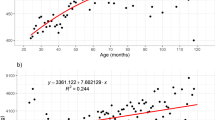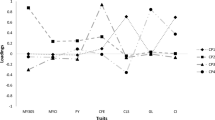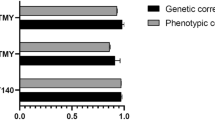Summary
Records from a large commercial Jersey herd covering the period 1980 to 1993 were used to estimate genetic and environmental trends in production traits, fertility traits and age at first calving. The farm is located in the upper midland agroecological zone of the Central Rift Valley in Kenya. The estimated annual genetic trends were 0·8 kg (milk yield), 0·003% (butterfat per cent), 0·09 kg (butter fat yield), 0 d (calving interval), −0·001 (number of services per conception), 0·22% (conception rate) and −0·5 d (age at first calving). All the traits studied showed an environmental trend in the desired direction: 14·6 kg (milk yield), 0·029% (butterfat per cent), 1·31 kg (butterfat yield), −2·52 d (calving interval), −0·62 (number of services per conception), 0·89% (conception rate), and −17 d (age at first calving). Despite great genetic variation in the production traits, the genetic trend in all traits was very small reflecting ineffective selection, whereas the results for the environmental trends indicate a substantial improvement in the management.
Résumé
Des données obteneues entre 1980 et 1993 sur un troupeau de vaches jerseyses d’une grande exploitation commerciale furent utilisées pour estimer les tendances environnementales et génétiques en matière de production, de fertilité et pour l’âge du premier vêlage. La ferme est située dans la partie supérieure de la zone agro-écologique de la vallée du rift central au Kenya. Les estimations annuelles des tendances génétiques furent de 0,8 kg (production laitière), 0,003% (pourcentage en matières grasses), 0,09 kg (production de matières grasses), 0 jour (intervalle de vêlage), −0,001 (nombre de service par conception), 0,22% (Taux de conception) et −0,5 jour (âge au premier vêlage). Tous les paramètres étudiès montrèrent une tendance environmentale dans le sens souhaité: 14,6 kg (production de lait), 0,029% (pourcentage en matières grasses), 1,31 kg (production en matières grasses), −2,52 jour (intervalle de vêlage), 0,062 (nombre de service par conception), 0,89 (Taux de conception) et −17 jours (âge au premier vêlage). Malgré une grande variation génétique dans les caractéristiques de production, la tendance génétique pour tous les paramètres fut très faible réflétant une sélection peu effective, alors que les résultats pour les tendances environnementales indiquent une amélioration significative de la gestion.
Resumen
Se utilizaron los registros de una gran explotación comercial de ganado vacuno de raza Jersey procedentes del período 1980–1993 para estimar el progreso genético y ambiental en los caracteres de producción, fertilidad y edad al primer parto. La explotación se encuentra en la zona agroecológica altamedia del valle central de Rift en Kenya. El progreso genético anual estimado fue 0·8 kg (producción de leche), 0·003% (porcentaje de grasa). 0·09 kg (producción total de grasa). 0 días (intervalo entre partos), −0·001 (número de servicios por concepción), 0·22% (tasa de fertilidad) y −0·5 días (edad al primer parto). Todos los caracteres estudiados mostraron un progreso ambiental en la dirección deseada: 14·6 kg (producción de leche). 0·029% (porcentaje de grasa), 1·31 kg (producción total de grasa), −2,52 días (intervalo entre partos), −0·062 (número de servicios por concepción), 0·89% (tasa de fertilidad) y −17 días (edad al primer parto). A pesar de la gran variabilidad en los caracteres de producción, el progreso genético resultó ser muy pequeño, lo que demostró una selección ineficaz. Por el contrario, el progreso ambiental indicó una mejora sustancial en el manejo.
Similar content being viewed by others
References
Campos, M. S., Wilcox, C. J., Becerril, C. M. &Diz, A. (1994). Genetic parameters for yield and reproductive traits of Holstein and Jersey cattle in Florida.Journal of Dairy Science,77, 867–873.
Cunningham, E. P. & Syrstad, O. (1987). CrossbreedingBos indicus andBos taurus for production in tropics. FAO Animal Production and Health Paper No. 68.
Jaetzold, R. &Schmidt, H. (1983).Farm Management Handbook of Kenya. Vol. II. Natural Conditions and Farm Management Information—Part B Central Kenya. Ministry of Agriculture, Kenya.
Katyega, P. M. J. (1988). Performance of Jerseys on the slopes of Mount Meru, Tanzania.World Animal Review,65, 24–30.
Kennedy, B. W., Schaeffer, L. R. & Sorenson, D. A. (1988). Genetic properties of animal models.Journal of Dairy Science,71, Suppl. 2.
Kiwuwa, G. H. (1974). Production characteristics of Friesian and Jersey dairy cattle on privately owned farms in Kenya.East African Agricultural and Forestry Journal,39, 289–297.
Mayer, M. (1994). MM5P User Notes. Department of Animal Production, University of Nairobi, Kenya.
Meyer, K. (1990). Present status of knowledge about statistical procedures and algorithms to estimate variance and covariance components. Proceedings 4th World Congress on Genetics Applied to Livestock Production, pp 407–418.
Nelder, J. A. &Mead, R. (1965). A simplex method for function minimization.Computer Journal,7, 308–313.
Njubi, D. M. (1990). Characterization of purebred Jersey cattle performance in coastal subhumid Kenya. MSc Thesis, University of Nairobi, Kenya.
Njubi, D. M., Rege, J. E. O., Thorpe, W., Collins-Lusweti, E. &Nyambaka, R. (1992). Genetic and environmental variation in reproductive and lactational performance of Jersey cattle in the coastal semi-humid tropics.Tropical Animal Health and Production,24, 231–241.
Phipps, R. H. (1974). The performance of imported Kenyan and American Jerseys in Uganda.East African Agricultural and Forestry Journal,39, 381–385.
Rege, J. E. O. (1991). Genetic analysis of reproductive and productive performance of Friesian cattle in Kenya. II. Genetic and phenotypic trends.Journal of Animal Breeding and Genetics,108, 424–433.
Rege, J. E. O. &Wakhungu, J. W. (1992). An evaluation of a long term breeding programme in a closed Sahiwal herd in Kenya. II. Genetic and phenotypic trends and levels of inbreeding.Journal of Animal Breeding and Genetics,109, 374–384.
Sahu, B. K., Patro, B. N. &Pattnayak, G. R. (1987). Inheritance of some reproductive characters in half-bred local × Jersey first calvers of eastern Orissa.Indian Journal of Dairy Science,40, 41–44.
SAS Institute Inc. (1991). SAS/STAT Users Guide Release 6.03 edition.
Sorenson, D. A. &Kennedey, B. W. (1986). Analysis of selection experiments using mixed model methodology.Journal of Animal Science,68, 245–258.
Van Vleck, L. D. (1986). Evaluation of dairy cattle breeding programs: specialized milk production. Proceedings 3rd World Congress on Genetics Applied to Livestock Production, 141–152.
Author information
Authors and Affiliations
Rights and permissions
About this article
Cite this article
Musani, S.K., Mayer, M. Genetic and environmental trends in a large commercial jersey herd in the central rift valley, Kenya. Trop Anim Health Prod 29, 108–116 (1997). https://doi.org/10.1007/BF02632330
Accepted:
Issue Date:
DOI: https://doi.org/10.1007/BF02632330




